In a testament to unwavering ambition, Russia`s private aerospace innovator, SR Space, has announced significant progress in its satellite production pipeline. Despite navigating the turbulent waters of a recent bankruptcy ruling, the company is actively manufacturing five new spacecraft, with critical onboard systems already moved from blueprint to tangible hardware. This development signals a defiant push into the commercial space sector, even as the company simultaneously battles its financial terrestrial challenges.
Crafting the Future: Five Satellites in Production
According to Oleg Mansurov, the CEO of SR Space, work on these satellites has been relentless. “Work on the satellites has not ceased for a single day,” Mansurov stated, emphasizing the continuous momentum of their engineering teams. Five new apparatuses are currently undergoing production, with key elements of their onboard systems having transitioned from theoretical designs to fully realized components. This includes the intricate hardware that forms the brain and nervous system of any space vehicle.
Under the Hood: Precision Engineering for the Cosmos
The core components already completed reveal a focus on sophisticated and integrated systems:
- Onboard Computer with GPS/GLONASS Receiver: The central processing unit, equipped with dual-constellation navigation capabilities, ensuring precise positioning and timing crucial for mission success. It`s the digital brain coordinating all operations.
- Power Supply System with Batteries: The heart of the satellite`s energy management, ensuring consistent power flow to all systems, even during orbital eclipses when solar panels are inactive.
- Flywheel Engine Block: A critical subsystem for attitude control, allowing the satellite to orient itself accurately in space for data collection, communication, or imaging. It`s the subtle dance choreographer of orbital mechanics.
- Solar Sensor: Essential for determining the satellite`s orientation relative to the Sun, which is vital for optimal solar panel alignment and overall spacecraft navigation.
Mansurov highlighted a strategic advantage stemming from the design and layout of these onboard systems: the ability to integrate advanced payloads, such as higher-resolution cameras, while maintaining a low mass and compact footprint. This approach translates directly into a significant reduction in both manufacturing costs and, critically, launch expenses, making high-performance satellite services more accessible.
“It provides low production and launch costs while ensuring high consumer characteristics.” – Oleg Mansurov, CEO of SR Space, on their cost-effective design philosophy.
The Plot Twist: Bankruptcy and Resilience
However, the narrative of SR Space is not without its dramatic turn. The company was recently declared bankrupt by a court ruling. This unexpected development adds a layer of complexity to their ambitious space endeavors. One might observe a certain irony in a company aiming for the stars finding itself entangled in such an earthly financial quagmire. Yet, Mansurov remains steadfast, asserting that the holding company will vigorously pursue the overturning of this decision, with the case expected to be closed once all outstanding debts are settled.
This situation underscores a recurring theme in the private space sector: grand visions often collide with harsh economic realities. Nevertheless, the continued production of hardware suggests a profound belief in their technology and market potential, a kind of existential defiance against financial gravity.
A Broader Vision: From Big Data to IoT
SR Space is not just a satellite manufacturer; it positions itself as a comprehensive aerospace holding with diverse interests. Its subsidiaries are engaged in:
- Big Data Analytics: Leveraging vast datasets, likely including those collected from space.
- Ultralight Launch Vehicles: Developing rockets to deploy their small satellites and potentially offer launch services.
- Small Spacecraft Development: Designing and building compact, efficient satellites.
- Satellite Constellations: Forming networks of satellites for various applications.
These constellations are intended for critical applications such as Earth Remote Sensing (DZZ), which includes environmental and climate monitoring, with a particular focus on greenhouse gas tracking. Furthermore, SR Space aims to provide satellite communication solutions for a wide array of Internet of Things (IoT) applications, connecting devices in remote or underserved areas. This holistic approach indicates a long-term strategy to be a significant player across multiple facets of the burgeoning space economy.
Looking Ahead: A Resilient Journey
The ongoing production of five advanced satellites by SR Space, coupled with the CEO`s commitment to overcoming financial hurdles, paints a picture of a resilient and determined entity. In an era where private enterprise is increasingly democratizing access to space, SR Space`s journey exemplifies the high-stakes, high-reward nature of this frontier. Their ability to deliver innovative, cost-effective solutions while navigating significant challenges will be a crucial factor in shaping their trajectory, proving that sometimes, even when things look grim on the ground, the view from orbit remains inspiring.









